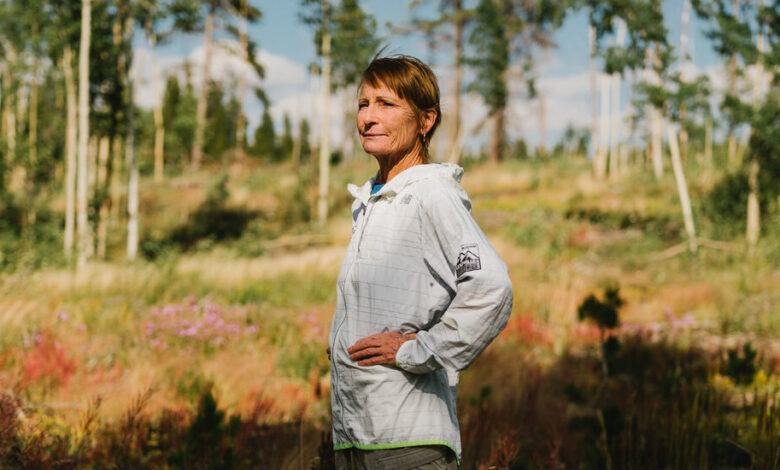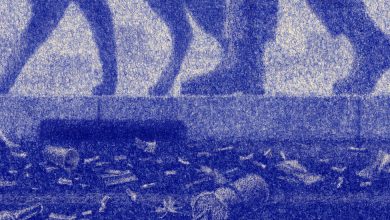‘They’re Waiting for Me to Die’: A 72-Year-Old Runner Will Not Let This Race Go

LEADVILLE, Colo. — In the crisp predawn hours last August, 71-year-old Marge Hickman slipped the brace off her sprained ankle and eased to the starting line of the Leadville Trail 100-mile race. Part of her said go home. The race wasn’t what it used to be. She didn’t feel wanted anyway. She loved this race. She hated this race. She revolved her entire life around this race.
She would finish this race, she told herself. She buttressed herself with her positive phrases. L.N.D. (leave no doubt). One direction: forward. Let go; let God. When the shotgun finally boomed, Hickman, a five-foot, 100-pound runner, plodded nervously into the thin, chilled air of the Rocky Mountains. If she could finish, she would be the oldest woman to ever do so.
Hickman is a well-known figure at the Leadville 100, a brutal, high-altitude race that weaves through the mountains with an elevation gain of 15,744 feet. She is masochistically obsessed with the race, according to friends, who point to two surgeries on her shoulders; two procedures for Plantar fasciitis, which causes heel pain; and a plate inserted into her wrist.
She has finished the race 14 times, but not in over a decade. She sheepishly admits as much but is adamant that she is still kicking butt and, in her words, “taking names.” Her training log — an average of 80 miles a week — and an array of ultramarathon results back up her claims. “I learned to let go of ageism a long time ago,” she said, adding, “Without that race on my calendar, I don’t know what I’d do or who I’d be.”
Ultrarunning has long provided a powerful draw for true eccentrics. They include Bob Wise, who suffered brain trauma in a car crash but discovered that longer races provided a respite from the noise in his head. Despite his drooping posture and a penchant for running into trees, he competed in numerous six- and seven-day races and race-walked 903 miles in the first certified 1,000-mile race.
Then there’s the Scottish runner Arthur John Howie, who once held three world records: running 360 miles nonstop, a 1,300-mile race in 16 days 19 hours and the speed record across Canada in 72 days 10 hours. His preferred fuel? Copious amounts of beer.
Jameelah Abdul-Rahim Mujaahid, a single mother of five, started running ultras on the weekends, after a day job as a district manager for four Burger Kings and night shifts at the Waffle House. At 54 years old, she has completed over 200 ultramarathons.
For Hickman, exercise needed to be extreme to offset lifelong bouts of anxiety and depression. In her 20s, she said, she fled Pittsburgh and a childhood marred by insecurity and neglect for the mountains of Colorado. The snow-capped peaks hunched against the horizon and the rush of clear mountain streams became symbols of her transformation from a timid child, made to wear glasses by her parents in an attempt to make her smarter, into a self-possessed athlete.
When the doors of her gym opened at 6, she would run on the carpeted track. “Then an aerobics class,” she said. “At lunch, I’d take an hour and a half and run five miles. I’d do a quick wipe up, put the jeans back on and some perfume and head back to work. After I got off, I was back for racquetball.”
But it was in a running shop in Denver in 1984 where destiny seemed to find her. She met Jim Butera, a bearded hippie who ran obscure races called “ultras,” sold running shoes and professed extreme running as a way of life. “I thought he was the best thing since canned corn,” Hickman said. When he showed her a flier for his latest idea, a 100-mile race in the mountains of Colorado — a race across the sky — it sounded impossible. She was hooked.
Her Leadville initiation in August of that year was a jarring portent of the relationship she would have with the race for the rest of her life. After face-planting on a root near Mile 13, she pushed on with blood oozing from her knees and face and a twisted ankle rapidly swelling. Eighty-seven miles later, tears began to flow as she limped over the last hill and saw the finish line.
The same year her love affair with Leadville began, her first marriage ended. “Because of my exercise addiction,” Hickman admitted.
The next year, she won the women’s division and placed 11th overall. She returned like a homing pigeon for the next 27 years — finishing 13 more times — making her the most prolific female runner in Leadville’s storied history.
In 1997, she wed again, this time to a runner on an iconic peak of the course during her beloved race. The couple moved to the city of Leadville in 2004, and she further enmeshed herself in the ever-expanding series of Leadville races.
But in 2010, the series was sold to Life Time Fitness. What had felt like a cozy affair among like-minded trail bums became a Disneyland of the mountains. Prices climbed, a gift shop was added and the field ballooned from 625 participants in 2011 to 943 by 2013.
Hickman turned contemptuous after Butera died in 2012 and the race came and went without mention of the former race director. By that time, the race had long been led by Ken Chlouber and Merilee Maupin. Chlouber has been widely credited with popularizing the race. In her book on the history of the Leadville 100, Hickman made her views crystal clear: The race was the brainchild of Butera alone. She and Chlouber have been at odds since, and in 2019, her brazenness got her banned.
Chlouber did not respond to requests for comment.
Hickman was reinstated for the 2021 race, after pressure from runners, including Gary Corbitt, son of the ultrarunning legend Ted Corbitt. She had another shot to cross the line.
Hickman was exactly where she wanted to be when she reached the halfway point. She had completed 13 hours and still had over 16 hours to finish. She felt stronger than she had in years. In any other major 100-miler, barring injury, she would have been home free.
But not at Leadville. New rules enacted weeks before the race now gave her only four hours to get to the next aid station. According to race officials, the changes were made to ease congestion. In effect, Hickman, and slower runners like her, were eliminated even though they most likely would have been able to finish before the 30-hour cutoff time.
She sat limp in a chair at Mile 50 while a volunteer cut her wristband, effectively disqualifying her from the race. In a daze, Hickman didn’t seem to notice. She stared at the clock, befuddled over what went wrong, emotion rumbling in her gut.
Initially, Hickman took a conspiratorial stance and referred to the fact that she is the most decorated Leadville veteran not inducted into the Leadville Hall of Fame. “They say they’re waiting for me to retire,” she said. “I say they’re waiting for me to die.”
Public declarations of closure followed. She was done with Leadville. She had enough. She was spent; her heart was no longer in it.
She signed up for the 2022 race five weeks later. Those who know her said it was inevitable. “Leadville’s been half my life,” Hickman joked sarcastically, a jumble of glee and heaviness in her voice. “It’s in your face — the hand of the mountains just comes out and gets you by the heart and sucks you in.”
In the third week of August, she will line up at Leadville again, determined to write her own ending.
“Yeah, I like to read books and stuff, but I’m a doer,” Hickman, now 72, added as she applied makeup over a black eye from a recent fall. “My plan is to run on. If they cut my wrist band, I’m just going to keep going. I’m going to finish my race.”





